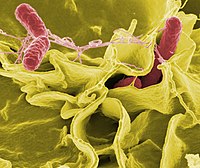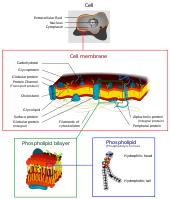
Cytocompatibility, physical properties, and antibiofilm activity of endodontic sealers with amoxicillin
Sign Up to like & getrecommendations! Published in 2017 at "Microscopy Research and Technique"
DOI: 10.1002/jemt.22898
Abstract: The aim was to evaluate the cytocompatibility of the AH Plus and Sealapex associated with amoxicillin (AA) in a quantity of 10% by total weight of the sealers, the flow and setting time of these… read more here.
Keywords: antibiofilm activity; setting time; physical properties; cytocompatibility physical ... See more keywords

Antibiofilm activity of phytochemicals against Enterococcus faecalis: A literature review
Sign Up to like & getrecommendations! Published in 2022 at "Phytotherapy Research"
DOI: 10.1002/ptr.7488
Abstract: Enterococcus faecalis is a leading causative pathogen of recalcitrant infections affecting heart valves, urinary tract, surgical wounds and dental root canals. Its robust biofilm formation, production of virulence factors and antibiotic resistance contribute significantly to… read more here.
Keywords: activity phytochemicals; review; enterococcus faecalis; activity ... See more keywords

Antibiofilm activity of coenzyme Q0 against Salmonella Typhimurium and its effect on adhesion–invasion and survival–replication
Sign Up to like & getrecommendations! Published in 2019 at "Applied Microbiology and Biotechnology"
DOI: 10.1007/s00253-019-10095-8
Abstract: Salmonella Typhimurium, a common Gram-negative foodborne pathogen, threatens public health and hinders the development of the food industry. In this study, we evaluated the antibiofilm activity of coenzyme Q0 (CoQ0) against S. Typhimurium. Besides, the… read more here.
Keywords: salmonella; salmonella typhimurium; survival replication; typhimurium ... See more keywords

Antimicrobial and antibiofilm activity of the EeCentrocin 1 derived peptide EC1-17KV via membrane disruption
Sign Up to like & getrecommendations! Published in 2020 at "EBioMedicine"
DOI: 10.1016/j.ebiom.2020.102775
Abstract: Background The antibiotic resistance and biofilm formation of pathogenic microbes exacerbate the difficulties of anti-infection therapy in the clinic. The structural modification of antimicrobial peptides (AMP) is an effective strategy to develop novel anti-infective agents.… read more here.
Keywords: antimicrobial antibiofilm; ec1 17kv; membrane; bacteria fungi ... See more keywords

Liposomes containing biosurfactants isolated from Lactobacillus gasseri exert antibiofilm activity against methicillin resistant Staphylococcus aureus strains
Sign Up to like & getrecommendations! Published in 2019 at "European Journal of Pharmaceutics and Biopharmaceutics"
DOI: 10.1016/j.ejpb.2019.04.011
Abstract: HIGHLIGHTSA biosurfactant (BS) was isolated from human Lactobacillus gasseri BC9.BS inhibited biofilms of methicillin resistant S. aureus (MRSA) strains.BS loaded in liposomes (BS‐LP) enhanced the antibiofilm activity.Lyophilized matrices containing BS‐LP were formulated for topical application.… read more here.
Keywords: lactobacillus gasseri; aureus; methicillin resistant; antibiofilm activity ... See more keywords

Antibiofilm activity of glycolic acid and glyoxal and their diffusion-reaction interactions with biofilm components.
Sign Up to like & getrecommendations! Published in 2022 at "Food research international"
DOI: 10.1016/j.foodres.2021.110921
Abstract: Biofilms on food-contact surfaces act as potential reservoirs of microbial pathogens and can cause operational problems. The search for effective biofilm control agents is a significant research need. In this study, glycolic acid (GA) and… read more here.
Keywords: antibiofilm activity; glycolic acid; reaction; diffusion ... See more keywords

Antibiofilm activity of nanosilver coatings against Staphylococcus aureus.
Sign Up to like & getrecommendations! Published in 2021 at "Journal of colloid and interface science"
DOI: 10.1016/j.jcis.2021.11.038
Abstract: Implant infections due to bacterial biofilms constitute a major healthcare challenge today. One way to address this clinical need is to modify the implant surface with an antimicrobial nanomaterial. Among such nanomaterials, nanosilver is arguably… read more here.
Keywords: staphylococcus aureus; nanosilver coatings; pure sio2; antibiofilm activity ... See more keywords

Surface functionalization of central venous catheter with mycofabricated silver nanoparticles and its antibiofilm activity on multidrug resistant Acinetobacter baumannii.
Sign Up to like & getrecommendations! Published in 2019 at "Microbial pathogenesis"
DOI: 10.1016/j.micpath.2019.103832
Abstract: The mycofabrication of silver nanoparticles (AgNPs) through green chemistry protocol is an advanced methodological progress in medical nanotechnology. Mycofabricated AgNPs are less toxic due to an aura of biomolecules around the nanoparticles. Hence the mycofabricated… read more here.
Keywords: microscopy; surface; antibiofilm activity; mycogenerated agnps ... See more keywords

Antibacterial and antibiofilm activity of bone marrow-derived human mesenchymal stem cells secretome against Vibrio cholerae.
Sign Up to like & getrecommendations! Published in 2019 at "Microbial pathogenesis"
DOI: 10.1016/j.micpath.2019.103867
Abstract: The ability of V. cholerae to survive and spread in the aquatic environment combined with the scarcity of effective antimicrobial agents, especially those effective against multidrug-resistant strains highlights the need for alternative non-antibiotic approaches for… read more here.
Keywords: antibacterial antibiofilm; cholerae; msc secretome; antibiofilm activity ... See more keywords

Antibiofilm properties of copper (II) and iron (III) complexes with an EDTA-based phenylene macrocycle and its acyclic analogue against food and clinical related pathogens
Sign Up to like & getrecommendations! Published in 2021 at "Polyhedron"
DOI: 10.1016/j.poly.2021.115076
Abstract: Abstract Bacterial food-borne and nosocomial infections are a public health issue around the world that is exacerbated by biofilm formation and acquired resistance to antibiotics. New therapies focusing on the prevention of biofilm formation may… read more here.
Keywords: antibiofilm activity; phenylene macrocycle; macrocycle acyclic; based phenylene ... See more keywords

Peptide Stability Is Important but Not a General Requirement for Antimicrobial and Antibiofilm Activity In Vitro and In Vivo.
Sign Up to like & getrecommendations! Published in 2022 at "Molecular pharmaceutics"
DOI: 10.1021/acs.molpharmaceut.2c00918
Abstract: Peptide stability to proteases has been a major requirement for developing peptide therapeutics. This study investigates the effects of peptide stability on antimicrobial and antibiofilm activity under various conditions. For this purpose, two human cathelicidin-derived… read more here.
Keywords: stability; peptide stability; antimicrobial antibiofilm; antibiofilm activity ... See more keywords